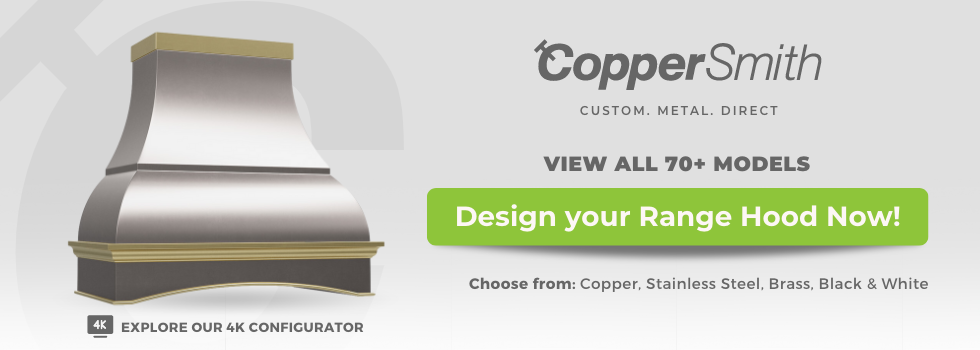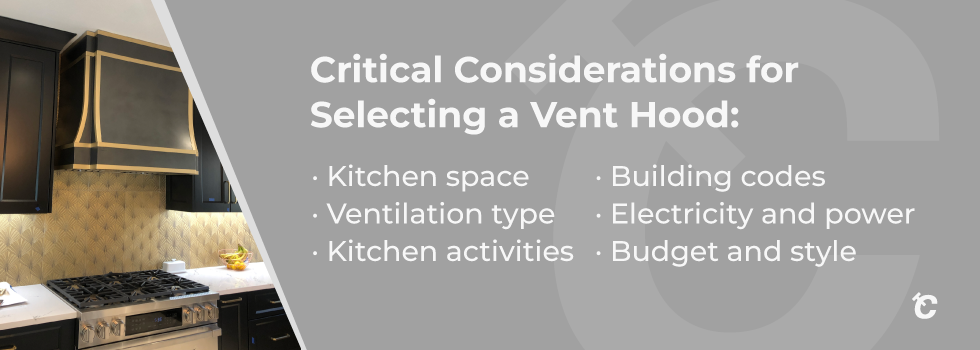
Vent hoods are essential parts of every kitchen. They provide fresh air into the cooking area and prevent food from being contaminated by smoke or odors.
People also refer to vent hoods as range hoods or ventilation hoods.
Regardless of what you call it, however, a vent hood consists of an exhaust fan installed above the cooking surface of a stove or oven.
The fan pulls smoke and grease fumes out of the kitchen through ductwork and vents them outside. This prevents odors from building up inside the home and makes the air cleaner and healthier.
All kitchens need a cabinet hood to ensure proper ventilation and handle any cooking odors. But all of the ventilation hood options can get overwhelming.
What type of ventilation hood should you get? The answer depends on your needs, kitchen, budget, and style.
Choosing a kitchen vent hood isn't tricky, but it does take time and research. Luckily, we can help. Read on for a complete guide on choosing your new kitchen range hood.
Critical Considerations for Selecting a Vent Hood
There are several critical considerations for selecting a vent hood. We've listed them below for your convenience.
Kitchen space
The first thing to consider is the room size where you'll install the vent hood. A small space may require a smaller model, while larger areas may call for a more powerful unit.
Before buying your vent hood, ensure you have good measurements. Know the size of the kitchen island or gas cooktop you'll install the hood over.
Measure the area of the room in cubic feet and know exactly how much space you have.
Ventilation type
Secondly, look at the type of ventilation required by the area. For example, a fan-only vent hood might suffice if there is no air conditioning or heating system.
However, if there is a central HVAC system, you should select a vent with more power.
Kitchen activities
Thirdly, consider how much work you plan on doing in your kitchen. A simple fan-only model might do the trick if you use the vent hood occasionally.
But if you plan on using the vent hood regularly, then you'll probably want something that has an automatic shutoff feature.
Building codes
The next thing to consider is ensuring the vent hood meets local building codes.
Some states mandate specific minimum requirements for vent hoods, such as having a filter change indicator light.
Electricity and power
Another consideration is how you will power your range hood. Vent hoods use either electricity or gas to operate.
Electric models are quieter than their gas counterparts but cost more to run. Meanwhile, gas models are cheaper to run, but they make noise.
You'll want to consider both factors before making a decision.
Budget and style
Of course, you must also look into your spending to choose a vent hood that fits your budget. There's nothing worse than spending money on a product only to find out it doesn't work correctly. So make sure to pick a vent hood that matches your style in your budget.
Finally, think about your overall kitchen design, especially how the hood will look with your cooking appliances.
When you've considered all of these factors, you're ready to choose your vent hood.
Types of Vent Hoods
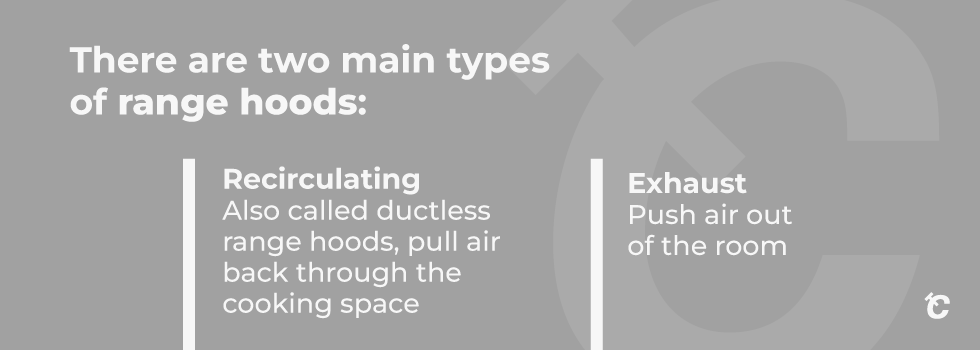
There are two main types of range hoods: recirculating and exhaust.
Recirculating vent hoods, also called ductless range hoods, pull air back through the cooking space, while exhaust vent hoods push air out of the room. Both types have pros and cons, so it pays to shop around before buying.
If you have the budget, a good rule of thumb is to purchase a model with at least three filters regardless of which vent type you choose.
Hoods usually use charcoal filters to capture particulate matter. With plenty of filters, you'll always have enough airflow to cook without clogging them up.
On the other hand, if you want to save some cash, go for a smaller model with fewer filters. You can always add more later if you need to.
Recirculating range hoods
The most common type of range hood is the recirculating or ductless hood. These models draw air back through the cooking zone, which is filtered and recirculated.
They come in different sizes and styles, including freestanding, built-in, and drop-in.
Freestanding overhead vent hood units are typically used when you want to keep the vent system separate from the rest of the kitchen. They work well above island cooktops as an island hood.
Plus, freestanding units usually require less maintenance because they aren't connected to plumbing or electrical systems.
Built-ins are ideal for kitchens with limited floor space. They're often mounted on an interior wall. In addition, cabinet vent hoods offer a stylish built-in option.
Drop-ins are perfect for small spaces. They slide over a standard vent pipe and are usually more affordable than cabinet range hoods.
Most ductless hoods feature a motorized fan that circulates air throughout the cooking area.
Some models also include a grill grate, which allows you to use the hood as a grilling station.
Other features include heat sensors, adjustable thermostats, and timers, which allow you to control the temperature and duration of the cooking process.
Exhaust range hoods
An exhaust range hood pushes air out of the kitchen instead of pulling it back through the cooking area.
These models are great for larger kitchens because they provide ample ventilation. Place them near your cooking appliances for maximum utility.
However, they may not work well for smaller kitchens because there isn't enough room for the air to circulate freely.
In addition, exhaust range hoods are louder than their recirculating counterparts. Therefore, be mindful of the noise level of an exhaust range hood. If noise is a concern, look for a quieter model.
Ventilation Hood Sizes
There are many different sizes of ventilation hoods available today. The most common ones are small (about 12 inches wide), medium (18 inches wide), and large (24 inches wide).
Each size has a specific purpose and can be used in various ways depending upon the application.
Smaller models are usually recommended if you have limited space. Larger models can be used when there is more room in the kitchen.
Furthermore, you may use a small ventilator hood for home cooking or baking. Meanwhile, a larger model could be used for commercial purposes like restaurants or bakeries.
If you do plan to use your ventilation hood primarily for regular cooking, make sure you choose a model that's big enough to handle the job. You don't want to buy a small model only to find yourself having to replace it after a few months.
Also, look for a model that includes a grill grate if you plan to use the kitchen hood as part of a grilling station. This will help prevent food from falling onto the stovetop.
Range Hood Placement and Installation
A range hood is designed to capture grease and odors before they escape through vents or ductwork.
It can be installed above or below the cooking surface but should never be placed directly under a vent.
Range hood installation may require a permit if you have a gas oven or gas range so make sure to check all regulations before moving forward with installation.
You can double-check regulations and permit requirements by consulting a professional. Before installing a range hood, check with your local building inspector to ensure it complies with all applicable laws.
If you don't have a permit, you can install a drop-in range hood over a wall or ceiling vent.
You also need to ensure that your chosen location is free of obstructions. For example, the space above your gas range or electric cooktop must have plenty of room for your new hood insert before installation.
If you're unsure how to install a vent hood, consider hiring a professional to perform the final installation unless you're dealing with a simple hood insert.
Someone with experience installing different types of range hoods will have more knowledge of how to install your new purchase properly.
Caring for Your New Range Hood
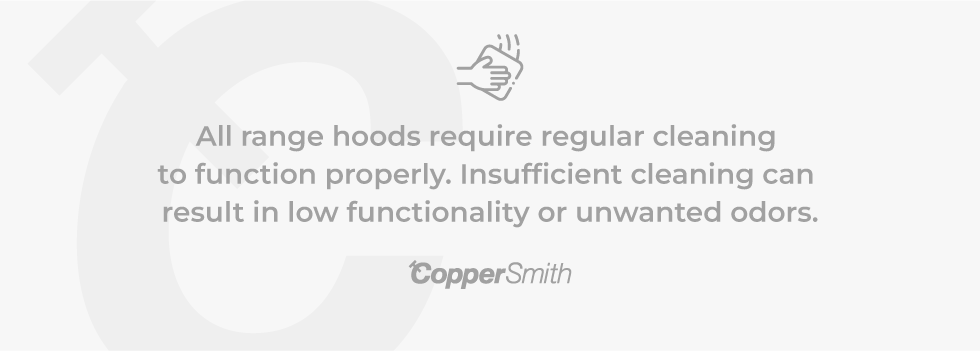
All range hoods require regular cleaning to function properly. Insufficient cleaning can result in low functionality or unwanted odors.
Homeowners can easily clean their range hood filters using dish soap or baking soda. You should also consider simply replacing the filter when it has reached the end of its usable life.
You may also need to replace your range hood fan. This is particularly true of outdoor vent hoods more exposed to the elements.
Consult your new range hood manufacturer for best practices regarding care and maintenance.
Conclusion
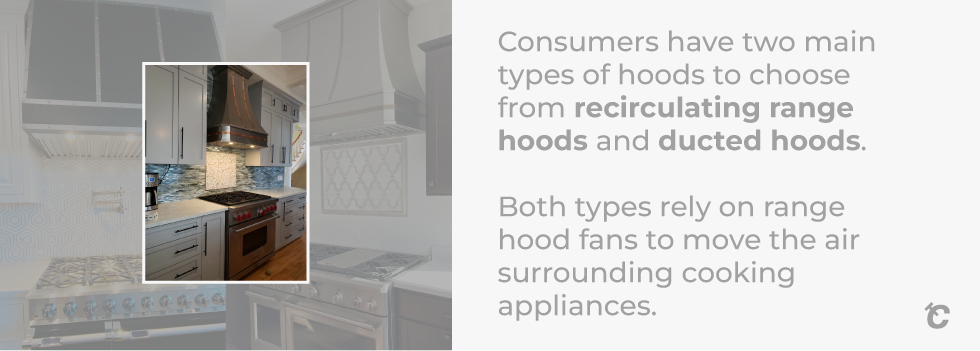
Choosing a new vent hood for your kitchen can be daunting and exciting. Vent hoods are essential to any kitchen setup; placing them above electric or gas stoves can improve your kitchen functionally and aesthetically.
Consumers have two main types of hoods to choose from recirculating range hoods and ducted hoods. Both types rely on range hood fans to move the air surrounding cooking appliances.
Homeowners may also want an outdoor vent hood for grilling. Ducted hoods work best for outdoor applications.
Looking for a stylish new range hood? CopperSmith can help. We offer a wide selection with a hood for every kitchen.
Don't know what type of hood you want? We've got you covered there, too. Our sales representatives can help you choose between options such as downdraft hoods, wall-mounted canopy hoods, chimney hoods, and more.
Ready to find the vent hood of your dreams? Visit our website and get your custom quote today.

